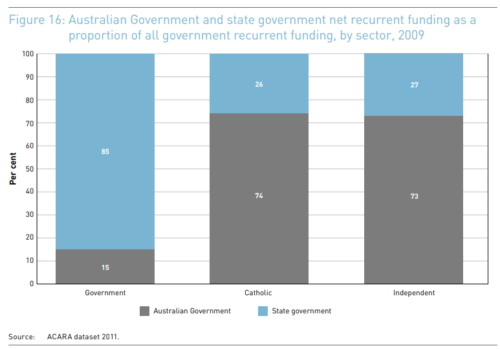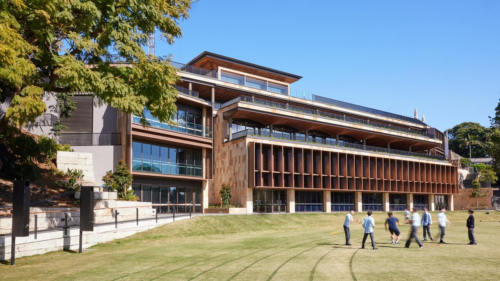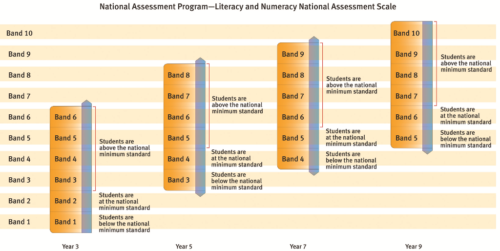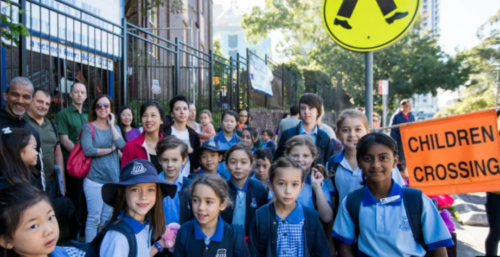

At the end of the first decade of the 21st century, Australia was experiencing a decline in educational outcomes for school students. This was reflected in a fall in the rankings of PISA, an international assessment designed to compare the educational standards of different countries (Senate Select Committee on School Funding, 2014). Further, the OECD found that Australia had one of the largest gaps between its highest and lowest-performing students among developed nations that comprise its membership (Senate Select Committee on School Funding, 2014). In response, then-Education Minister Julia Gillard commissioned a report chaired by businessman David Gonski. The report was delivered in December 2011, and with Julia Gillard by then the Prime Minister, education reform became a priority of the Gillard Government.
But how did this come to be? The root of this issue lies with how our Constitution designates education a responsibility for state governments, not the Commonwealth government. Accordingly, states run their own systems of state schools, and most of their education funding is directed towards these schools (Gonski, et al., 2011). However, in the 1960s, the Commonwealth began providing funding for non-government schools to address concerns about resource adequacy amid rapidly growing school enrolments during the post-war population boom (Gonski, et al., 2011). A Constitutional Amendment in 1942 which transferred income taxation powers from states to the Commonwealth also decreased the funding capabilities of states, necessitating Commonwealth funding (Gonski, et al., 2011).
In 1972, the new Whitlam government appointed a committee headed by Professor Peter Karmel, an economist who focused on educational issues, to produce a report with recommendations for the government (Campbell, 2019). The Karmel Report was the first comprehensive plan by the Commonwealth government to intervene in the education system (McLaren, 2014). Most significant among its recommendations was that the Commonwealth should not centralise the education system by directly controlling how schools were run, but rather set overarching priorities and provide funding for resources (Hill, 1998). It was believed a diversity of approaches to education would allow schools to experiment and improve. Another key aspect of the report was its emphasis on equality of opportunity. The report recognised that social and economic inequalities were being perpetuated by unequal educational opportunities (Hill, 1998). It recommended a needs-based funding model for schools – each school’s available resources being assessed against a common resource standard to determine the funding needed. This common resource standard was also to be set at much higher levels than previous funding would indicate (Marginson, 1997).
Implementing the recommendations proved tricky. The report specifically asked for the Commonwealth to stop funding the wealthiest schools, already exceeding the common resource standard. However, lobbying by the impacted schools led to the change being quashed so that the reforms could pass the Senate, then controlled by a conservative majority (Marginson, 1997). The Catholic schools division grants being given to the Church to administer rather than handed directly to schools further compromised the reform’s ability to introduce school equity (Campbell, 2019). In the end, the greatest impact of the Karmel Report was the dramatic increase in Commonwealth funding for schools rather than equalisation (Marginson, 1997). Although it established the Disadvantaged Schools Program, a precursor to later programs of targeted grants to disadvantaged areas, the funding dedicated to the program was hardly adequate (Marginson, 1997). Some also believe that the report viewed private schools too positively and failed to identify the inherent socio-economic advantages enjoyed by these schools. They saw the resulting funding model as allowing these schools to proliferate in the decades after, muscling out a focus on improving public education (Marginson, 1997).

Source: ACARA. A breakdown of funding per educational institution type.
Over the next few decades, the Commonwealth became the primary funder of non-government schools, while state governments primarily funded state schools (Gonski et al., 2011). Changes in government and scattered priorities meant the ideals of the Karmel Report were gradually lost. The Gonski Report (2011) found that “Australia lacks a logical, consistent and publicly transparent approach to funding schooling.” In many ways, the Gonski Report is a repetition of the Karmel Report, calling for a new schooling resource standard, funding of schools based on socio-economic status of its students, extra funding for disadvantaged schools, and greater independence of schools to make its own decisions (Hinz, 2013). Similar to its predecessor, though, the implementation of these new recommendations was hamstrung by politics. Pressured by the opposition and private school interests, Gillard made a commitment even before the report was released that no school would lose a dollar (Baker, 2022). This echoed the failure of the Whitlam Government in stopping funding to the wealthiest schools. Because of the comprehensive reform recommended by the report, Gillard also needed agreement from the states. These state governments protested the National Plan for School Improvement – based on the Gonski Report – for a variety of reasons. Some saw it as micromanagement, while others singled out the infeasibility of providing the extra funding required by the agreement (Hinz, 2012). Ultimately, only New South Wales, South Australia and the ACT fully implemented bilateral agreements with the Commonwealth. The other states later formed agreements with the new Abbott Government on a watered-down funding model (Senate Select Committee on School Funding, 2014).
The Gonski reforms have been of much controversy and contention over the last decade. Governments following its implementation have over promised and underdelivered on educational reforms, with standards consistently stagnating or deteriorating in the last decade, despite continued economic growth and increased funding. Most recently the Turnbull government released the Gonski 2.0 review, aimed at optimising school funding for students’ educational outcomes.
This “Gonski 2.0” reform recommended that governments provide funding on an as needs basis (Bonner et al, 2022), a solution that initially promised to reduce the gaps and improve the overall standard of education. This culminated in the creation of a school resource standard or SRS (Department of Education, 2017), an estimate of how much total public funding a school needs to meet its student’s educational needs. Currently, the Commonwealth Government funds $16,413 per secondary school student per year, with additional allocations for disadvantaged students . This SRS base amount is calculated by considering the number of students enrolled in a school by the funding amount allocated to that school. The education act 2013 does however consider a private school’s ability to cover operating costs through school fees and subsequently applies a discount of up to 80% to this SRS commitment. Each school is given a “capacity to contribute percentage”, from which discounts are applied to SRS.
It can thus be inferred that so-called elite private schools (the Melbourne Grammars or Scotchs of the country) receive funding of $3283 per student, the maximum discount permitted under the education act. This comes on top of money given to private schools for developing new buildings and facilities, something not always offered to public schools. Another interesting comparison of private school funding can be made through similar countries’ approaches. Australia is the only country in the OECD that provides public funding to fee-charging private schools. This was recently highlighted by The Australian Learning lecture, a 10-year initiative designed to bring innovation to education, which asserts that “We (Australia) are the world leader when it comes to giving public money to private, fee-charging schools”.

Source: Caulfield Grammar School. An exclusive pool for only CGS students, with $600,000 of $25 million provided by the government.
Despite this funding per student increasing year on year, from $19 billion in 2018 to a promised and predicted $33 billion in 2029, Australia currently sees stagnating or declining educational outcomes for its students. Between 2012 and 2018 there was a statistically significant decline in educational outcomes in both reading and math (Productivity Commission, 2023). One area of particular concern for the government remains the educational outcomes of so-called “priority equity cohorts”. Within this group (which consists of Aboriginal and Torres Strait Islanders, students in regional areas, and those experiencing other disadvantages) fewer than half meet the minimum educational standards. The results nationwide haven’t been much better, with over 90,000 students failing standardized literacy and numeracy tests.
Educational outcomes across schools become even more significant when considering the growing importance of attaining minimum educational standards. The Productivity Commission recognises that the consequences of secondary school performance will continue to grow as we move towards a technologically fuelled economy. The national skills Commission estimates that 90% of all jobs created in the next 5 years will require an education level beyond secondary school (NSC, 2022). When this is considered in tandem with our languishing education outcomes, one must ask what this means for those students left behind in the coming years, especially for those marginalised communities classified under the “priority equity cohorts”.
With this funding of private schools in mind, we must reflect on the goals of education in our country. Is it to improve the educational standard by some “average metric”, or should it be to ensure all students reach some minimum educational standard? If those most disadvantaged are not meeting basic educational benchmarks, do we really need to keep funding private schools servicing the most privileged in our society?

Source: Daily Telegraph. Cranbook’s official opening of a state-of-the-art upgrade to school facilities.
When it comes to understanding the school system, the Australian public relies heavily on oversimplified dichotomies such as public/private or free/fee-paying (Thompson et al, 2019). Factors like the Gonski scheme and governments fluctuating funding between different types of schools largely escape public notice, with most parents simply preferring to send their children to a high-level private school. This choice can result in inequity. Rowe (2016) surmised that in Victoria, schools perceived as “popular” or more desirable receive exacerbated funding from private institutions and parental donations entirely separate from government contributions. As parents implicitly support already flourishing schools through attendance, and alumni financially give back to their old schools, the gap in educational resources is further widened.
Almost without exception, public schools have primarily catered to students from lower socio-economic class and disadvantaged areas (Gonski et al, 2011). Unfortunately, governments have not signalled this demographic focus as a concern. They have instead created a scheme for voluntary school fees targeted towards selective, segregated public schools (Rowe & Perry, 2022). This method is harmless and beneficial on the surface but contains subtly malicious undertones due to the segregation and inequality it engenders upon an industry where inequalities have already been rife for decades. Hierarchies are created due to exacerbated school segregation divided through socio-economic lines. These are indirectly linked to lower or comparatively different funding infrastructure. One potential method to solve these issues would involve analysis of the impact of parent-generated financial revenue and the rapid growth of parents as highly selective yet vastly influential non-state fund contributors (Rowe & Perry, 2019). The main consequence of parental funding for selective urban public schools, which tend to be more highly regarded socio-economically, is that it very often overlooks the stratums of potential academic underachievement that has arisen in the past due to this informal system (Perry, 2018). This is visible particularly for minorities that are underrepresented and underfunded by both government and parental-financing schemes. It is alarming to note that all public schools across Australia (except ACT) are apparently funded well under their SRS requirements despite these evident discrepancies (Fair Funding Now, n.d.).
While the justification of over-funding a particular selection of schools according to needs-based funding still exists, the proven decline in academic standards depict the need to cease or curb funding in areas where it is not directly required. Another potential solution would be to solve the problem of systemic underachievement itself. There are two key methods to do this, one of which is to focus on providing students with intensive, early, targeted support from the moment they start to fall behind in studies (Perry, 2018).

Source: NAP. NAPLAN, a standardised test used to assess student achievement levels.
The other main method to solve underachievement in standardized tests concerns focussing on building socially integrated schools, encouraging parents from every background to send their children to government schools. This will ensure all children receive the minimum standardised academic requirements through a more equal distribution of funding. To reach this goal, the SRS should ideally be funded at 100% in every state and territory. Furthermore, educators and community representatives are demanding a removal of the 20% cap on the Commonwealth share of the SRS from the Australian Education Amendment Act (AEU, 2021). Should these necessary actions be taken, and with its subsequent increased funding, the next step would be to encourage as many parents as possible–particularly from the geographic and socioeconomic backgrounds that have historically been victimized by underfunded schools–to enrol their children and demand the rights for fully funded and supported education.
Additionally, a further possible solution would be to promote more versatile and dynamic distributions of students across schools. Particularly in NSW and Sydney, schools are overcrowded, and overfunding is a directly correlating factor to this dilemma. To mitigate this issue, the current government should transition beyond short term fixes and deliver fast-tracked, long-term solutions instead to avoid the failure of inadequate schooling due to missing basic infrastructure (Sydney Morning Herald, 2018). Again, the solution is diverse, collaborative funding in order to ensure students reach a minimum educational standard.
It’s interesting to evaluate the emergence of venture philanthropy in funding public education. Funds that have ambitious goals to fuel large educational reforms sourced from “philanthrocapitalism” may be the ones most important to direct to the right areas to save floundering, underfunded, overlooked public schools (Rowe, 2022). Philanthropy wants to invest in areas that are going to change systems for the betterment of future generations and societies. Thus, it is worthwhile to encourage these donors to look into solving the issue of Australia’s deeply fractured public-school/private-school divergence while the nation awaits the government to reform laws.

Source: Singhal, I. T., Alexandra Smith and Pallavi. Some of Sydney’s most overcrowded schools have grown by 40 per cent.
To conclude, Australia is proven as one of the markedly first-world countries with one of the poorest distributions and most glaring inequalities in its education systems. While past schemes such as Gonski initiatives have fallen behind on adequately keeping up with the nations’ complex educational needs, funding and authoritative institutions must be encouraged otherwise. Ranging from parents to governments to philanthropic organizations, all must be encouraged to invest whole-heartedly in this intrinsic, fundamental economic and social harvesting of human capital, both for future economies and to save Australia’s future communities. Only by doing this can we hope to provide our children with the best possible education so they can harness the brightest of horizons.
Australian Education Union (AEU) Victorian Branch. Fix deep funding inequity for public schools. (2021, May 27). https://www.aeuvic.asn.au/fix-deep-funding-inequity-public-schools
Australian Government. (2013). Australian Education Act 2013.
Baker, J. (2022, February 18). No Gonski ‘nirvana’: Why Australia’s most ambitious education reforms have failed. The Sydney Morning Herald. https://www.smh.com.au/education/no-gonski-nirvana-why-australia-s-most-ambitious-education-reforms-have-failed-20220215-p59wpj.html
Bonner, C., Greenwall, T. (2022). Waiting for Gonski: How Australia failed its schools. New South Wales, Australia: UNSW Press.
Campbell, C. (2019, January 3). Jean Blackburn and social justice through education. DEHANZ. https://dehanz.net.au/entries/blackburn-jean-and-social-justice-through-education/
Department of Education. (n.d.). Schooling Resource Standard. Recurrent funding for schools, Schooling Resource Standard. https://www.education.gov.au/recurrent-funding-schools/schooling-resource-standard
Department of Education, Skills and Employment. (n.d.). How are schools funded in Australia? Recurrent funding for schools, Resources. https://www.education.gov.au/quality-schools-package/resources/how-are-schools-funded-australia
Gonski, D., Boston, K., Greiner, K., Lawrence, C., Scales, B., & Tannock, P. (2011). Review of Funding for Schooling—Final Report. Department of Education, Employment and Workplace Relations. https://www.education.gov.au/download/1307/review-funding-schooling-final-report-december-2011/1280/document/pdf
Hill, P. W. (1998, October 8). Reshaping Schooling in Australia. Paper 1: Reshaping Schooling in Australia. Schools in Australia: 1973-1998 The 25 years since the Karmel Report, Sydney. https://research.acer.edu.au/research_conference_karmel/1
Hinz, B. (2012, September 5). State stoush: The Gonski reforms and the political battle ahead. The Conversation. http://theconversation.com/state-stoush-the-gonski-reforms-and-the-political-battle-ahead-9258
Hinz, B. (2013, April 19). Explainer: What is a ‘Gonski’ anyway? The Conversation. http://theconversation.com/explainer-what-is-a-gonski-anyway-13599
Marginson, S. (Ed.). (1997). The Karmel report and educational equality. In Educating Australia: Government, Economy and Citizen since 1960 (pp. 46–70). Cambridge University Press. https://doi.org/10.1017/CBO9781139166966.005
McLaren, J. (2014, February 1). Karmel Report: Schools in Australia. DEHANZ. https://dehanz.net.au/entries/karmel-report-schools-australia/
National Skills Committee. (2022). Projecting Employment to 2026. Canberra, Australia. Insights. https://www.nationalskillscommission.gov.au/insights/projecting-employment-2026
Perry, L. (2018, April 20). To reduce inequality in Australian schools, make them less socially segregated. The Mandarin. https://www.themandarin.com.au/91533-to-reduce-inequality-in-australian-schools-make-them-less-socially-segregated/
Productivity Commission. (2022). Review of the National School Reform Agreement.
Public schools are missing out on resources to fund additional teachers & support staff, smaller classes & school infrastructure. (n.d.). Fair Funding Now. https://www.fairfundingnow.org.au/the_issue
Rowe, E. E., & Lubienski, C. (2017). Shopping for schools or shopping for peers: Public schools and catchment area segregation. Journal of Education Policy, 32(3), 340-356.
Rowe, E. E. (2022). Philanthrocapitalism and the State: Mapping the Rise of Venture Philanthropy in Public Education in Australia. ECNU Review of Education, 20965311221128840.
Rowe, E., & Perry, L. B. (2022). Voluntary school fees in segregated public schools: how selective public schools turbo-charge inequity and funding gaps. Comparative education, 58(1), 106-123.
School overcrowding must be addressed sooner rather than later. (2018, February 10). The Sydney Morning Herald. https://www.smh.com.au/national/nsw/school-overcrowding-must-be-addressed-sooner-rather-than-later-20180208-p4yzqe.html
Senate Select Committee on School Funding. (2014). Equity and excellent in Australia schools [Senate Select Committee Report]. Senate Select Committee on School Funding. https://www.aph.gov.au/Parliamentary_Business/Committees/Senate/School_Funding/School_Funding/Report/index
Singhal, I. T., Alexandra Smith and Pallavi. (2017, April 13). Some of Sydney’s most overcrowded schools have grown by 40 per cent: new data. The Sydney Morning Herald. https://www.smh.com.au/education/some-of-sydneys-most-overcrowded-schools-have-grown-by-40-per-cent-new-data-20170413-gvk49n.html
Thompson, G., Hogan, A., & Rahimi, M. (2019). Private funding in Australian public schools: a problem of equity. The Australian Educational Researcher, 46(5), 893-910.
The CAINZ Digest is published by CAINZ, a student society affiliated with the Faculty of Business at the University of Melbourne. Opinions published are not necessarily those of the publishers, printers or editors. CAINZ and the University of Melbourne do not accept any responsibility for the accuracy of information contained in the publication.